1986 Monaco Grand Prix race report
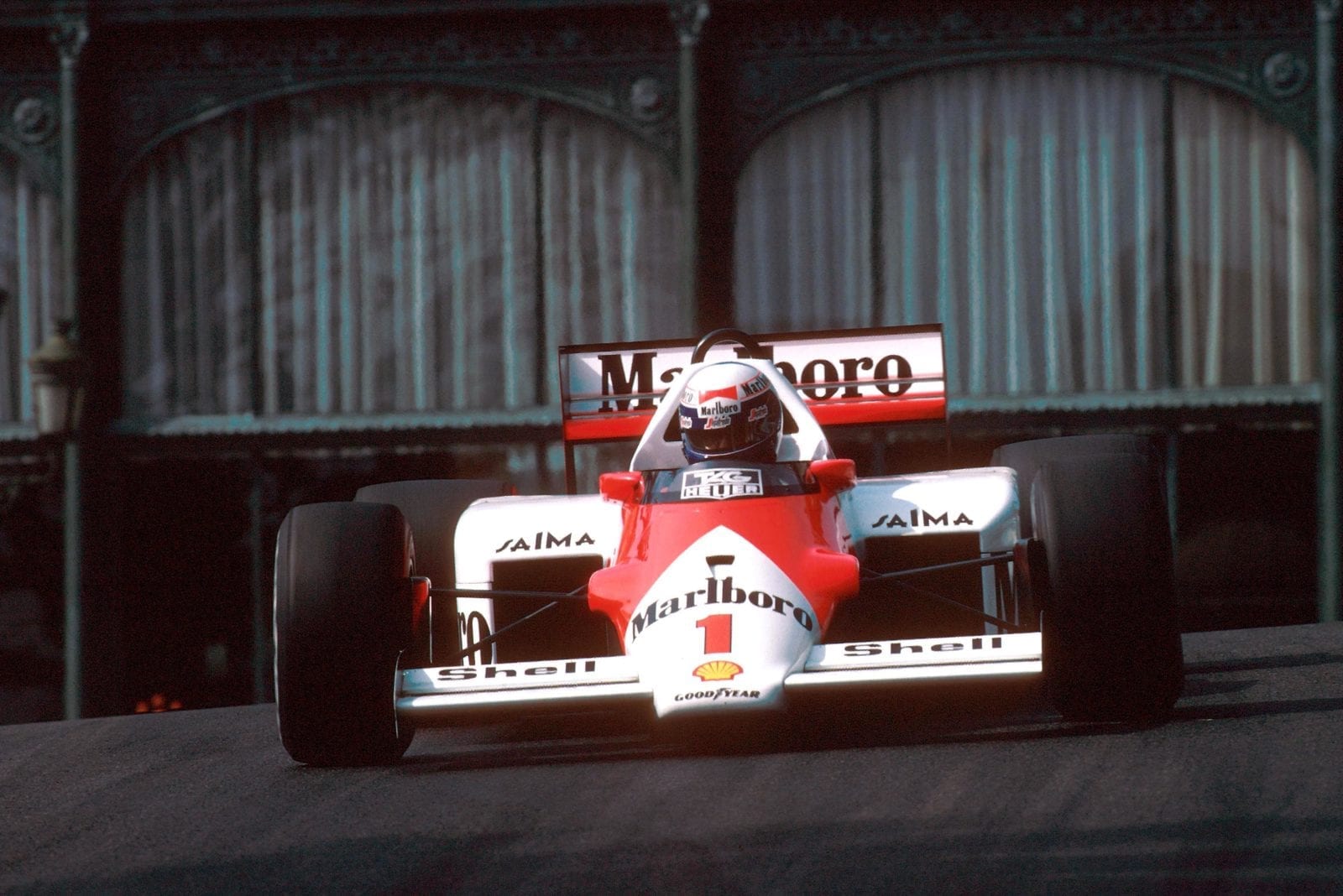
McLaren's Alain Prost took his third consecutive Monaco win
Motorsport Images
Taken overall the annual Monaco GP round the streets of Monte Carlo never really got off the ground. As a modern Grand Prix race the Monaco event is something of an anachronism which the Formula One circus tolerates for various obscure reasons, but if we had to be there every month instead of once a year, I feel a lot of us could go off Formula One. After a rather disappointing race at Imola two weeks before we felt that an exciting Monaco event would even things up, but it just did not happen. There is no pre-race practice or testing at Monaco so the first time that the cars are driven in the Principality each year is when they start official practice on Thursday morning, which itself is an unusual situation, for everywhere else practice is on Friday and Saturday in readiness for Sunday’s race. At Monaco it is on Thursday and Saturday, with Friday given over to French national club races, so that by Friday evening you can easily forget why you are in Monte Carlo.

Michele Alboreto threads his Ferrari through Saint Devote
Motorsport Images
Although much play is made of the times recorded by the various drivers during the hour-and-a-half of practice and experimentation each morning they are not important, though they can be significant. The important times are those recorded during the one hour of qualifying each afternoon, as they are recorded in no holds barred runs with the engineers giving the driver everything they can for one blinding lap, and the driver really at 9 1/2 to 9 3/4 tenths. The air of unreality at Monaco was enhanced by Prost and Senna recording 1 min 24.8 sec on Thursday morning and Senna being fastest in qualifying on Thursday afternoon with 1 min 25.2 sec. The same thing happened on Saturday, in the morning Senna was fastest with 1 min 22.3 sec and in the afternoon Prost claimed pole position with 1 min 22.6 sec. It was all very confusing, and many of the drivers and teams were confused as well. Neither qualifying hour was straightforward; on Thursday everything was stopped about a quarter of the way through when Streiff’s new Tyrrell 015 stopped in the tunnel and had to be retrieved by a breakdown lorry.
When activity restarted it was not long before there was an involuntary pause after Piquet’s Williams blew up its Honda engine and spread oil about. There was a final flurry in the last 10 minutes, but the whole session had been a messy affair. It looked as though the Japanese had got their microchips muddled up, as four of the powerful Honda V6 engines had blown up during the day. At the other end of the pit lane the Ford team was getting along nicely, with both Jones and Tambay now in Ford V6 powered cars, with a spare car available and a fourth monocoque, tub in the transporter.
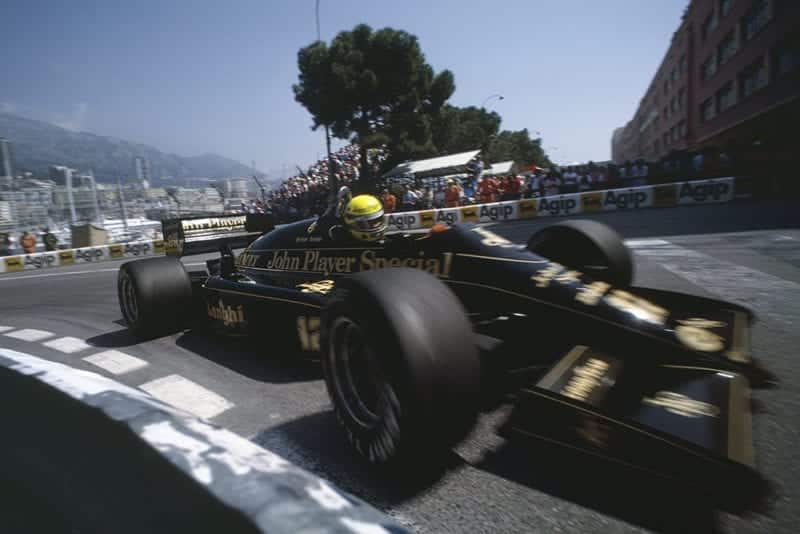
Ayrton Senna both qualified and finished 3rd in his Lotus
Motorsport Images
As at Imola John Barnard was back at the Woking base working on a new design, leaving the running of the McLaren team to his competent engineers and mechanics and their number one driver and as always the team seems to run as smoothly as the McLaren MP4/2C looks and Prost drives. Other team engineers were looking puzzled or worried, depending on whether their own results made sense, or they understood the rather confused pattern of events, especially with Arnoux in third place with the Ligier, Alan Jones in sixth place with the Ford, Piquet down in thirteenth place and Mansell and Dumfries with their works cars not even qualified! FISA limits the Monaco race to 20 starters, due to its tightness, so that six hopefuls were going to have to be spectators, Mansell’s lowly position was due to engine failures in his own car and in the spare car, and Dumfries crashed his Lotus 98T on his second lap in the morning, which meant he had done no practice at all when qualifying started.
On Saturday afternoon Senna and Piquet started the ball rolling, but de Cesaris soon put a stop to it when his Minardi spewed oil all round Tabac corner and into the Swimming Pool complex. Qualifying was not stopped, but there was little point in trying to set a time until the oil had been cleared. Eventually Mansell went out in good health and immediately hauled himself up from the non-qualifiers into the top ranks, and for a moment he held pole position.
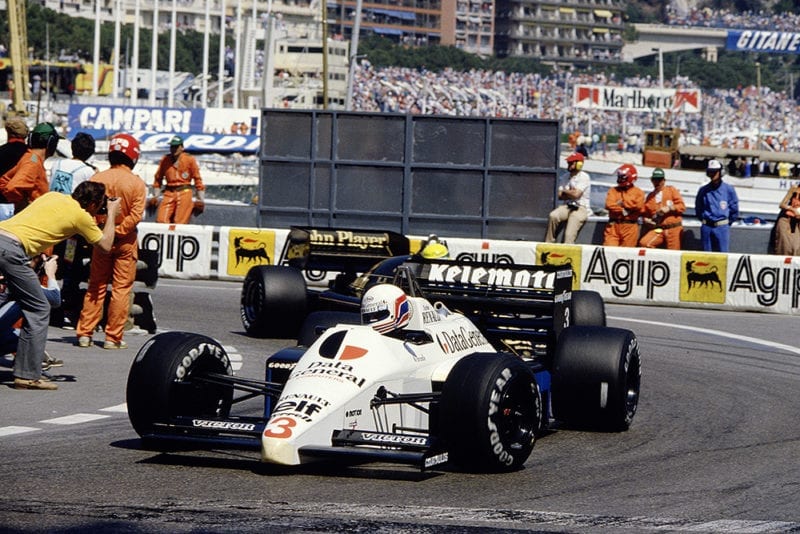
Martin Brundle was eliminated on lap 67 after tangling spectacularly with Patrick Tambay’s Haas
Motorsport Images
There was a big flurry in the dying minutes of the qualifying hour and all the stars were thrashing round, either getting in each other’s way or falling over slower drivers who were desperately trying to scratch their way into the Top Twenty. Amidst it all the quiet, unassuming, Mr Prost was circulating on his own looking for the opportunity to get a lap clear of other cars, and he found it right at the end and promptly took pole position on his last lap. It was done so unobtrusively that few people noticed and all the “heroes” who had been battling for top honours were almost speechless, except Rosberg, who was not surprised, knowing the inner details of the set-up of the car, the engine, the analytical approach to the problem by the engineers, and Frost’s uncanny aptitude for logical thinking.
One thing that was noticed as qualifying ended was that Alan Jones had hit the barriers at Ste Devote, due to the Lola front suspension collapsing when he put the brakes on. The Ford engines were going well, and Tambay was a very creditable eighth on the grid in his first event with the interesting new Cosworth-built engine.
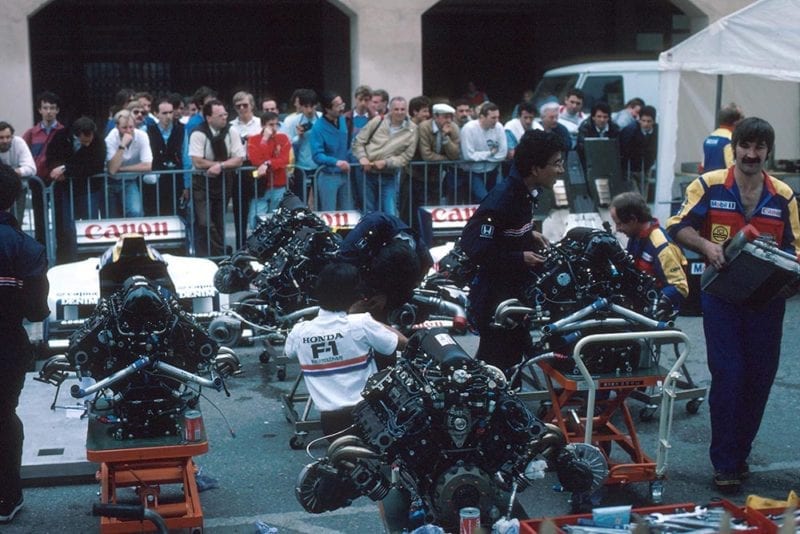
Honda power units wait in anticipation of being installed into their Williams chassis
Motorsport Images
The Monaco GP does not start until 3.30 pm as HRH Prince Rainier, in whose “back garden” we are playing, does not want to miss his Sunday lunch, nor do the thousands of spectators in every hotel and restaurant around the circuit who are paying over the odds for their meal but have a ring-side seat as part of the menu. In consequence there is a long gap between Sunday morning “warm-up” half hour and the start, but there is plenty for the team mechanics to do as anything that might give trouble is renewed before the race. New brake discs, new lower gears in the gearbox, rear driveshafts and many other things are changed. While watching all this I heard a familiar sound above the caterwauling of the public address system. It was the unmistakable sound of a straight-eight. fuel-iniected, desmodrormic valve, Mercedes-Benz 300 SLR racing engine, and sure enough the factory 1955 demonstration sports car was being driven round the circuit in company with many other Mercedes-Benz sports and touring cars, though nobody seemed to know why or what it was all about and this parade was not on the programmed schedule of events. If it was supposed to represent Daimler-Benz and 100 years of the car, you would never have known.
With superb weather we began to look forward to an exciting race to make up for the confused and disappointing two days of practice and qualifying. With the 20 cars lined up on the dummy-grid confusion was still with us, but this time it was concentrated in two small but vital pockets in the middle of the grid. The Ford engine in Tambay’s car was leaking oil from a cambox cover so rather than try and bodge a repair the Frenchman was transferred to the spare car and sent off just before the pit lane exit closed so that he could go round the circuit and regain his grid-position, while the stricken car was wheeled away.
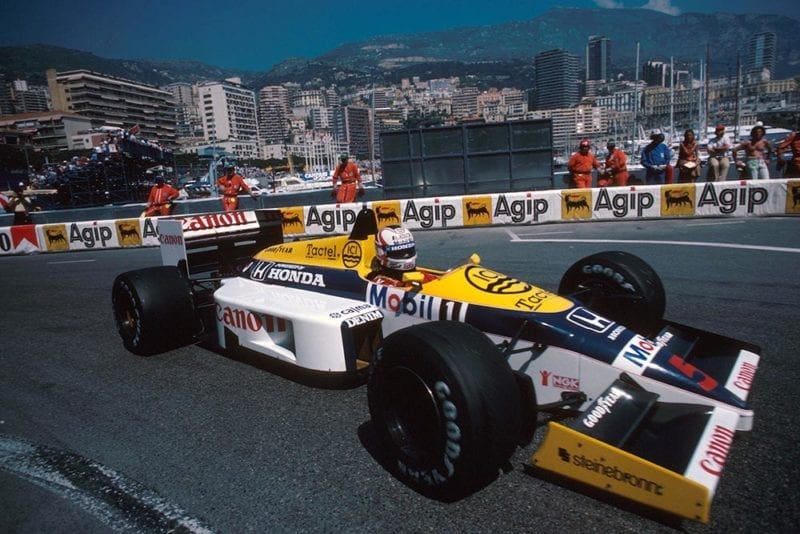
Williams’ Nigel Mansell qualified 2nd but couldn’t maintain that position in the race
Motorsport Images
The spare car was set-up for Alan Jones to drive, so there was pandemonium as seat, belts, pedals, wheel and so on were changed over, most of the required bits being on the car that officials were trying to get clear off the grid. It was all managed in time, but only just. Meanwhile the Ligier team were in similar trouble and Laffite was being changed over to their spare car, but they did not finish in time and Jacques was still putting on his helmet as the field went on the parade lap. This meant that he had to start the race from the back of the grid instead of the middle, in accordance with the rules.
The anticipated charge into the first corner didn’t happen. Prost made a smooth and unruffled start and just drove away from the rest. The Porsche engine characteristics were such that the McLaren went out of the slow corners so well that Honda or Renault power could not match it, even if they did propel their cars to a higher maximum on the short straights. It was all about torque curves and power delivery and even Rosberg managed to make good use of the characteristics. The likes of Senna, Mansell and Piquet knew they were beaten on the opening laps. Prost had demoralised them in qualifying and now it was all over, for nobody in his right mind expects Prost to make a driving error or the Porsche engine to break or the McLaren to fall apart, at least not under normal conditions and with the sun burning down on the packed Mediterranean Principality and the harbour full of expensive boats, all looked pretty normal, except the pace of the race, which was as slow as Prost needed to complete his domination. He only lost the lead for a few laps, when he stopped for new tyres, and was back in front when it was Senna’s turn to stop, and that was it.
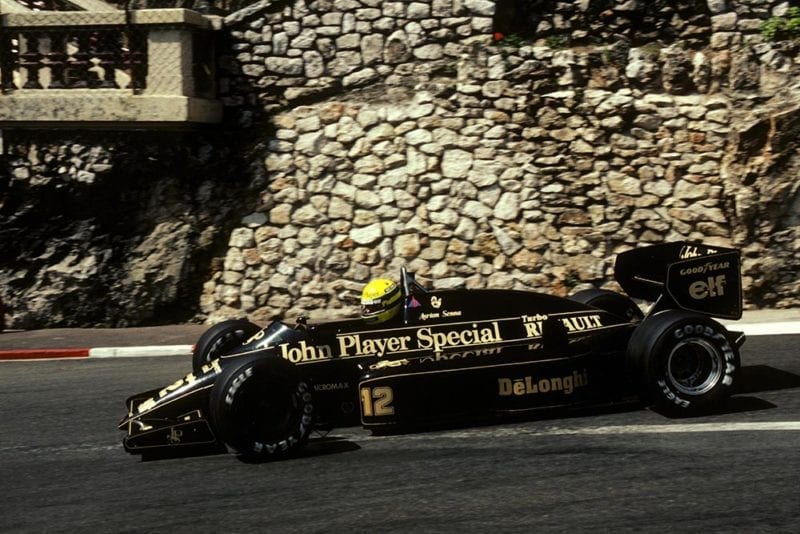
Senna dropped to 2nd in the championship after finishing behind Prost
Motorsport Images
The race actually ran for nearly two hours, these days an unheard of length of time for a Formula One driver to spend in his “office”, though some spent a lot less time at the wheel, notably Alan Jones, who tripped over Streiff’s Tyrrell 015 on lap three, spun and stalled and was pushed away into retirement by the marshals in the wrong direction of the course, which meant instant disqualification. If Jones had spun through 360 degrees instead of 180 degrees he could have been push-started in the right direction and gone on racing. Near the end of the race Tambay tripped over Brundle’s Tyrrell 015 and did a spectacular barrel-roll over the English car to land the right way up. If Ken Tyrrell is thinking of trying to get the new Ford engine for his cars in 1987 he had better tell his drivers to stop making the red and blue cars from Team Haas have accidents. Its not the Lola part that is important, it is what it says on that neat and tidy little power-plant that Cosworth is building up in Northampton that is important.
When it was all over I realised that the average speed of 134.634 kph and the fastest lap in 1 min 26.607 sec were new track records, for two major changes had been made when setting up the circuit this year. Worried about the speed of the cars out of the tunnel and down the slope to join the harbour front, the high-speed left right twitch was eliminated and replaced by a very slow left-hand corner and then a sweep round some bevelled kerbing on a plateau of concrete and tarmac built into the harbour on concrete piles. It all looked a bit silly, but it seemed to be effective enough, though the cars still left the tunnel at anything up to 177 mph, but they now had to brake almost to a standstill. In the area that used to be the old Gasworks Hairpin some new municipal road works had caused a revision of the so-called hairpin and the result was a huge improvement. Previously the exit onto the final straight up the finish was marred by an artificial island and bevelled kerb which threw the cars off balance.
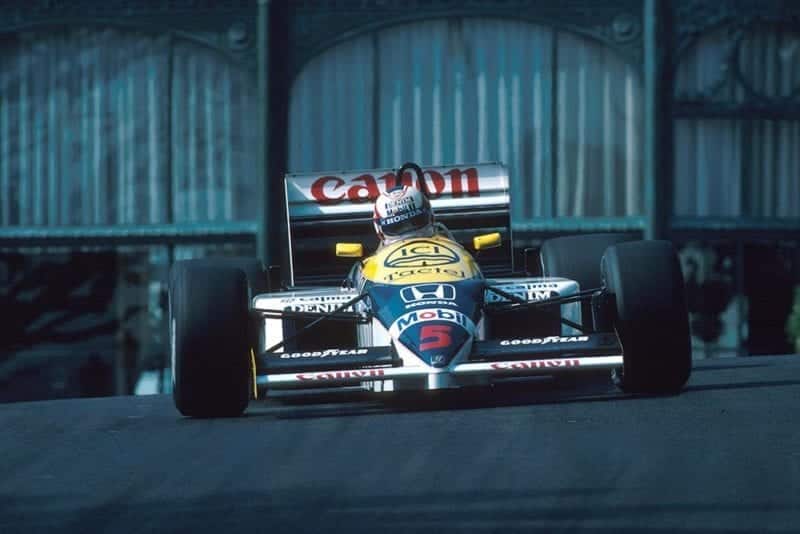
Mansell eventually finished 4th
Motorsport Images
Now the exit was smooth and progressive and the cars were doing 165 mph at the finish line. Both alterations seemed entirely acceptable, but they altered the official length of the circuit by a few metres, so this year’s race and lap times had to become new records with the slower entry onto the harbour front and the faster exit from Rascasse, the overall difference was minimal in time, but probably a good thing in effectiveness. — D.S.J.
